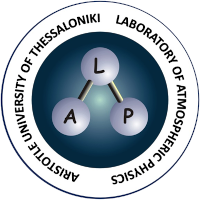The history of the Laboratory of Atmospheric Physics
The LAP members:
Following the establishment of the Chair of Atmospheric Physics in November 1979, LAP began to operate and was officially established two years later, in September 1981. It was initially co-located with the Meteorology Laboratory at the Meteorological Observatory of the University and was permanently relocated to the building of the Faculty of Sciences, in 1984. For twenty years LAP was directed by Professor Christos Zerefos (1981-2002) and was initially staffed by two scientific collaborators, Dr. Ioannis Ziomas and Dr. Alkiviadis Bais, who in the late 80’s were elected as lecturers in the School of Physics. Dr. Dimitrios Melas and Dr. Dimitrios Balis were elected as lecturers in 1999 and 2000, respectively. In 2001 and 2002, professors I. Ziomas and C. Zerefos left the Laboratory, while Dr. Kleareti Tourpali was elected as a lecturer (2004) and Dr. Chariklia Meleti as an assistant professor (2006). In 2015, Dr. Katerina Garane joined LAP as a Laboratory Teaching Staff (EDIP) member, followed by Dr. Chrysanthi Topaloglou, also as an EDIP member, in 2020.
Milestones in the history of LAP:
Immediately after the beginning of its operation, the first two instruments for measuring UV-A solar radiation and the experimental Canterbury-type ozone filter photometer were installed at LAP.
In 1982, the first commercially available Brewer MkII spectrophotometer was installed in LAP so as to continuously perform total ozone column measurements. The instrument became a part of the Global Atmosphere Watch international monitoring network of the World Meteorological Organisation and fully operates until today. As a result, LAP is included among the longest-running ozone measurement stations worldwide. At the same time, an air pollution monitoring program began its in situ measurements of SO2, NO2 and O3
In 1984, LAP organized the Quadrennial Ozone Symposium, hosting 220 participants, during which the Antarctic ‘ozone hole’ was first announced. Two more Quadrennial Ozone Symposia followed in 1995 and 2004.
Later, in 1992, new, innovative equipment was installed on the rooftop of the School of Physics building: a LIDAR system for measuring the vertical distribution of tropospheric aerosols, a dual-monochromator Brewer MKIII spectrophotometer for solar ultraviolet radiation spectrum measurements and two long-path DOAS systems (OPSIS and SANOA) to measure the horizontal column of gaseous pollutants in the boundary layer.
In 1993, under supervision of the Laboratory of Atmospheric Physics academic members, the Post-Graduate Program in Environmental Physics was founded in the School of Physics.
In 1997, new systems for calibration and optical characterization of the radiation instruments were developed and updated. Quality Control procedures were adopted and implemented on the measurements, while in 2000 the Lidar device was upgraded and LAP became a founding member of the European Aerosol Lidar Network. In the next 20 years, the Laboratory continued to obtain new and improve the existing scientific infrastructure. The next milestone (2006-2010) was the development of differential optical absorption systems for the measurement of tropospheric, stratospheric and total column of various atmospheric components.
In 2018, LAP organizes the 1st European Lidar Conference.
On December 2018, an FTIR spectrophotometer was installed in order to measure the total columns of greenhouse gases (CO2, CH4, N2O, CO) while two new multi-axis DOAS systems are being installed to improve the accuracy and quality of tropospheric and stratospheric column measurements of gaseous components of the atmosphere (such as NO2, O3, SO2, formaldehyde, etc.).
In 2019, LAP joins the PANACEA infrastructure (Hellenic infrastructure for the study of atmospheric composition and climate change) and significantly upgrades its remote sensing infrastructures, harmonizing with the standards of the European ACTRIS Infrastructure.
In 2022, LAP successfully organizes the quadrennial International Radiation Conference (IRS) (after being postponed in 2020 due to the COVID-19 pandemic).


